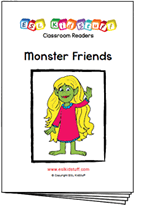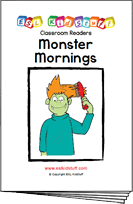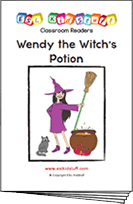Describing things (adjectives) lesson plan
Stand-alone lesson ESL kids lesson plan
Lesson plans for ESL kids teachers

Describing things (adjectives)
In this lesson, students practice using common adjectives to describe objects and then make comparisons. They play comparison games and complete a comparisons worksheet.
Members get accompanying worksheets, song and classroom reader.
Download materials:
Our lesson plans are FREE!
Sign up for accompanying:
✔ worksheets
✔ homework sheets
✔ craft sheets
✔ flashcards
✔ song downloads & videos
✔ classroom readers & videos
Click to see lesson details, materials and supplies
Time: 40 mins – 1 hour
Objectives: Describing things with common adjectives.
Structures: “Let’s look at~”, “What’s that?”, “It’s a/an (adjective)+(noun)”.
Target vocabulary: big, small, long, short, fat, thin, fast, slow, strong, weak, apple, pencil, cat, man, car, bear, mouse, snake, hippo, horse, lion.
Lesson materials
Flashcards:
Printables:
- Adjectives – draw the opposites worksheet
- Animal adjectives – write worksheet
- Reader worksheet
- Let’s look at the animals song – Listen and circle worksheet (use for the song)
- Let’s look at the animals song poster
Songs:
- Let’s look at the animals
Readers:
- Monster friends
Additional materials:
- Describing things vocab crossword
- Describing things vocab word search
- Opposite descriptions worksheet
Supplies:
- [hide_on_uk]colored[/hide_on_uk][hide_on_us]coloured[/hide_on_us] pencils
- large pieces of paper (A3 is ideal – 1 sheet per student)
- length of rope
- board with marker / chalk
- device to play the song on
In this lesson students will use some common adjectives to describe things and sing a catchy song about describing animals.
Lesson procedure:
Warm up and maintenance:
The beginning of your lesson is extremely important: this is where you set the tone of your lesson and get everyone in the right frame of mind for learning English. It is also an opportunity to check homework and review previous lessons.
Click for warm up suggestions for the start of your lessons
These activities can be done in the following order at the start of your lesson:

1. Greetings and name tags
Greet the students by name as they enter the classroom and gesture for them to sit down. Before class prepare some blank name tags (stickers or pin-on tags). Give these out and have everyone write their names and put their tags on. If you use pin-on tags, you can keep and give out every class.

2. Homework check
Check each student’s homework set in the last lesson. Ask each student some questions about their homework worksheet (e.g. “what [hide_on_uk]color[/hide_on_uk][hide_on_us]colour[/hide_on_us] is it?”), give lots of praise, and then put some kind of mark on the homework sheet (e.g. a sticker, a stamp or draw a smiley face). Finally, tell your students to put their homework back into their bags.
3. Review past lessons
Reviewing past lessons is very important – students need constant practice of new vocab, structures, songs, games and so on. Always review parts of your last lesson as well as some parts from other previous lessons. You can spend 5-10 minutes reviewing – it’s fine to recycle games and activities from your past lessons to review as kids enjoy playing familiar games (although be careful not to play a game to death!). See the section “Other ideas to include in your warm” below for ideas.
You can also include review activities in the main body of your lesson. Kids can have short attention spans so it’s good to be able to pull out lots of activities during different stages of the lesson.
Other ideas to include in your warm up:
Ball pass questions
This is good to review questions from previous lessons. Get everybody standing in a circle.
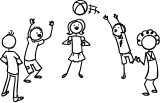
Round 1:
Take a ball and hold it and say, “My name is (you name)”. Then throw the ball to one student and say, “What’s your name?”. Students throw the ball around randomly, saying their names and asking for names.
Round 2:
This time ask a review question, e.g. “How many tables are there?”. Then throw the ball to a student who should answer, “There are (6) tables”. Help if necessary. Then that student throws the ball to another student and asks a “How many …?” question. Continue so everyone has a go. You can have multiple rounds with different topic questions.

Play “Spin the bottle”
Sit students in a circle with a bottle in the middle. Teacher spins the bottle. When it stops spinning the student it is pointing to has to answer a question. If the answer is correct then that student can spin the bottle. This is a good class warm up activity (e.g. How are you? What’s your [hide_on_uk]favorite[/hide_on_uk][hide_on_us]favourite[/hide_on_us] food? How’s the weather today?, etc.
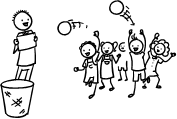
Play “Vocabulary basketball”
This is a fun game which reviews vocabulary from previous lessons. You will need a basket (a trash can) and 2 balls (or 2 pieces of A4 paper scrunched up into balls).
Form 2 teams and line them up so that two players from each team are facing the front with the basket in front of them. Let both players throw their ball – if they get their ball into the basket they can try and win a point by giving the correct answer to a question the teacher asks. This can be an actual question (e.g. What are you wearing?) or a flashcard (What’s this?). Then they go to the back of the line. At the end, the team with the most points is the winner!
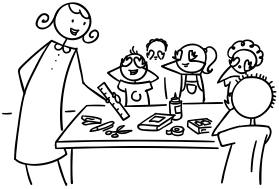
Play “What’s missing?”
This is a fun review memory game – students will have to try to remember review objects from previous lessons (e.g. classroom stationery). Lay the objects out on a table for all to see. Allow the students a minute to memorize the positions of the objects. Remove an object and hold it behind your back. Say, “Open your eyes!” – the first student who can shout out the missing object wins a point for his/her team. Play for all the objects.
Finally, calculate which team has won the most points and give them a round of applause.

Play “Quiz game show”
This is a fun quiz game, like a simple version of a TV game show. Draw some circles on the board and randomly write numbers 1, 2 or 3 in each circle. These will be points.
Put students into teams. Then ask the first team to choose a number – 1 is an easy question (e.g. “Do you like bananas?”) and 3 is a difficult question (e.g. point at a clock and ask, “What time is it?”). 2 will be in between in terms of difficulty. When the question has been answered correctly, erase that number circle. Play until all the number circles are gone – the team with the most points is the winner!
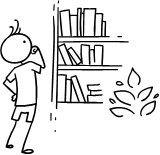
Read a classroom reader again
As you progress through the lessons you will start to build up a catalog of classroom readers (see our Readers download page at https://www.eslkidstuff.com). Kids love going back to old stories and reading through them again. Invite a student to pick a classroom reader and read through it as a class. Make the story as interactive as possible by asking questions (e.g. what [hide_on_uk]colors[/hide_on_uk][hide_on_us]colours[/hide_on_us] there are, the names of different objects, etc.) and getting students to speculate what is going to happen next in the story.

Talk about the weather (do after you have taught the weather lesson plan).
- Prepare a weather board. Before the first class prepare a piece of cardboard and cover it with felt – you are going to pin this to the wall. If you can, try and get blue felt (to represent the sky). Write at the top in large letters, “How’s the weather today?”. Below that write “Today it’s”. Cut out weather pictures (such as our weather flashcards) and stick some velcro on the back. Arrange the weather pictures around the edge of the board and then put the board on the wall of your classroom. You can now use this weather board at the beginning of every lesson.
- Ask about the weather. Ask, “How’s the weather today?” and have students put up their hands. Allow one weather condition per student (e.g. “It’s rainy”) and have each student come up and put a weather picture on the weather board.
- Introduce more weather vocabulary. Depending on weather conditions, you can introduce more weather words (with pictures … you can get students to draw them), such as:
- stormy
- misty
- showery
- freezing
- humid
- frosty
- icy
- drizzly
New learning and practice:
1. Introduce the adjectives
You are going to introduce the following adjectives by drawing pictures on the board: big / small, long / short, fat / thin, strong / weak, fast / slow. Don’t worry if you are not very artistic – even simple line drawings will do.
First start by drawing two lines vertically down the board so you divide the board into three equal sections. Then do the following for each set of adjectives:
- big / small: in the first section draw an apple (as shown below). Elicit “apple” and write “an apple” under the picture. Then, in the second section, draw a really big apple – fill up the whole section. Teach / Elicit “big” and write “a big apple” under the picture. Finally, draw a really small apple in the last section, teach / elicit “small” and write “a small apple”. Chorus each of the phrases three times. Then erase the pictures of the big and small apples. Invite one student up to the board and pointing in the middle section say, “draw a big apple”. Then invite another student up and say, “draw a small apple” pointing at the last section. Give each student a round of applause.

For the rest of the adjectives, follow the same drawing on the board procedure:
- long / short: draw a pencil (long and short).
- fat / thin: draw a cat (fat and thin).
- strong / weak: draw a man (strong – with big muscles, weak – a stick man with no muscles at all).
- fast / slow: draw a car (a fast, sporty car, zooming around and an old, broken down car with smoke coming out of the exhaust).


2. Play “Adjectives pictionary”
Start by playing on the board so everyone understands how to play. Erase everything from the board except the two vertical lines from the previous activity. Invite three students to the board and stand them in front of each blank section on the board and give them a marker / chalk each. Say, “Draw two thin snakes and one fat snake”. When the drawings are finished select a winner for the best picture. Play another round or two on the board with different students (use different adjectives and nouns each round).

Next, put students into groups of three and give each student a large piece of paper to draw on. Shout out the adjectives to draw and give everyone 1 minute to complete their drawings. At the end of 1 minute get everybody to hold up their pictures – you are the judge and you have to select the best picture from each group of three students as the winning picture. Then move onto the next drawings – play until all the adjectives have been practiced. Here are some ideas for drawings:
- thin / fat snakes
- big / small houses
- fast / slow snails
- long / short carrots
- strong / weak animals (e.g. dogs, lions, elephants, etc.)
3. Sing the “Let’s look at the animals” song
There are two options for this song – either listening and doing the worksheet or singing along doing the gestures. Or you can do both! See the Gestures section below for full details.
Lyrics for “Let’s look at the animals”
Chorus:
Let’s look at the animals,
Look, Look, Look! What’s that?
Verse 1:
It’s a bear and it’s big.
It’s a bear and it’s big.
It’s a big bear!
Chorus
Verse 2:
It’s a mouse and it’s small.
It’s a mouse and it’s small.
It’s a small mouse!
Chorus
Verse 3:
It’s a snake and it’s long.
It’s a snake and it’s long.
It’s a long snake!
Chorus
Verse 4:
It’s a hippo and it’s fat,
It’s a hippo and it’s fat,
It’s a fat hippo!
Chorus
Verse 5:
It’s a horse and it’s fast,
It’s a horse and it’s fast,
It’s a fast horse!
Chorus
Verse 6:
It’s a lion and it’s strong,
It’s a lion and it’s strong,
It’s a strong lion!
Gestures for “Let’s look at the animals”
There are two options:
- Listening worksheet – use the “Let’s look at the animals song – Listen and circle” worksheet. As you play the song students listen and circle the animal which best fits the description in the song.
- Actions. Get everyone to stand up and do the following actions as they sing along to the song:
- “Let’s look at the animals, Look, Look, Look!”: put your palm above your eyes as if you are looking into the distance
- “What’s that?”: point at an imaginary animal
- bear: act big and strong and show your claws
- mouse: act small and run around like a mouse
- snake: move your body like a slithering snake
- hippo: act big and fat (blow out your cheeks) and roar
- horse: gallop around like a horse
- lion: act big and strong and roar like a lion

[hide_on_uk]Short sample (members get full-length song):
[/hide_on_uk]
[hide_on_us]Short sample (members get full-length song):
[/hide_on_us]
4. Play “Animal races”
Now we will have fun running across the room using the animal vocabulary in the song. Clear all the tables and chairs from the room. Line everyone up at one end of the room and lie a rope across the other end of the room (the finish line). This isn’t going to be an actual race – there will be no prizes for the first across the finish line, but prizes can be given for the best performance (stickers, stars next to names on the class poster, praise, etc.).
Start modeling the first “race”: say, “Run like a big bear” and demonstrate running like a bear (roaring and clawing the air). Then start the race and give your prize to the best performance (at this point make it obvious that the fastest isn’t the winner – the best performance wins!).

Now do more races:
- run like a big bear
- run like a small mouse
- slither like a long snake
- wade across the river like a fat hippo
- gallop like a fast horse
- chase a deer like a strong lion

5. Do the “Adjectives – Draw the opposites” worksheet
Sit everyone down at their desks and give out the worksheets. Have the students draw the opposites. As they are working, circulate and ask questions (e.g. What is this?, Is this a slow horse?, etc.).
6. Read classroom reader “Monster friends”
We’ll end the lesson with a fun story. Before class, download and print off the reader “Monster friends”. As you go through each page, point to the pictures, elicit each of the different body parts and adjectives. Have fun asking other questions as well, such as the different [hide_on_uk]colors[/hide_on_uk][hide_on_us]colours[/hide_on_us] of the monsters, for example:
Teacher: (reading from the story) This is my friend Dodo (pointing at the picture). What [hide_on_uk]color[/hide_on_uk][hide_on_us]colour[/hide_on_us] is Dodo?
Students: He’s blue!
Teacher: Yes, that’s right! And look at his arms! Wow! He has … (eliciting the adjective)
Students: Long!
Teacher: Yes! He has long arms. And is he short?
Students: No, he’s tall!
Teacher: That’s right! He’s much taller than Susie!

Get the students really involved in the story by asking lots of questions and asking them if anyone in the class has similar characteristics to the monsters (e.g. the tallest student, the fastest student, etc.).
After reading the story, give out a reader worksheet to each student and have everyone match the monsters to their adjectives. Then go through the answers as a class.
Alternatively, watch our video version of the reader (Internet connection required).
Wrap up:
Assign homework: “Animal adjectives – write” worksheet
Click for wrap up suggestions for the end of your lessons

1. Assign homework
Each week give out a homework worksheet for your students to take home. Hold up the homework worksheet and model how to do it. Give out the worksheets and say, “Put your homework in your bags”.

2. Do “Quick check”
Time to leave the class. Make sure everything is put away and the students have gathered their belongings. Have them line up at the door and place yourself between the door and the students. For each student check one new word or phrase, for example:
- hold up an object or flashcard (such as an item of clothing) and ask, “What’s this?”
- ask a question from the lesson (e.g. “Where do you live?”, “Do you like bananas?”, “Can you play chess?”, etc.)
When they give you the correct answer say goodbye and let them leave. If their answer is wrong, have them go back to the end of the line – they will have to try again once they reach the front!
Other lesson plans
Actions, verbs & tenses:
- Can – for ability
- Morning routines
- Daily routines & times of the day
- Actions – Present continuous
- Future plans using “going to”
- Past tense activities – Regular verbs
- Past tense activities – Irregular verbs: Part 1
- Past tense activities – Irregular verbs: Part 2
Adjectives:
- Describing people
- Describing things
- Comparing things (Comparative adjectives)
- Comparing things (Superlative adjectives)
Adverbs:
Alphabet:
Animals:
Body:
Classroom:
Clothes:
Colors:
Colours:
Directions:
Family:
Feelings & emotions:
Food:
Health & sickness:
Holidays & festivals:
Jobs:
Likes, dislikes & favorites:
Likes, dislikes & favourites:
- Likes & dislikes
- [hide_on_uk]Favorites[/hide_on_uk][hide_on_us]Favourites[/hide_on_us] and asking why
Nature & Our world:
Numbers:
Places & where we live:
Prepositions of location:
Pronouns:
Shapes:
Shopping:
Sports:
Time, days, months, seasons:
Toys:
Transport & travel:
Weather:


